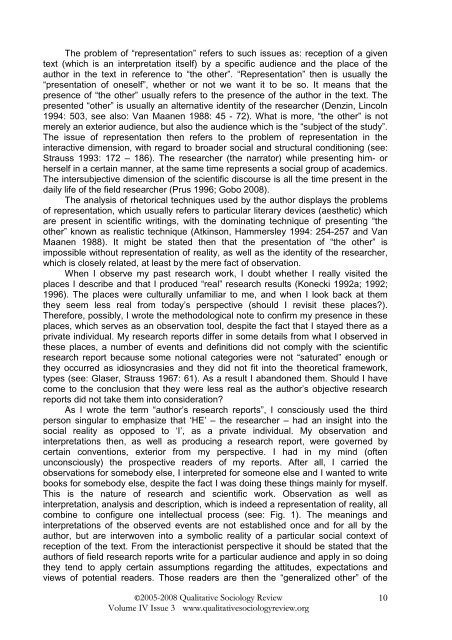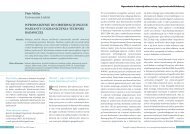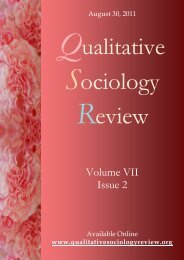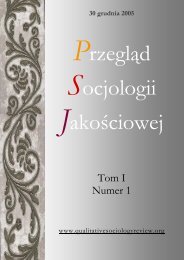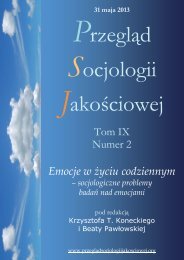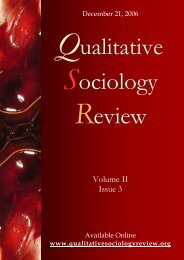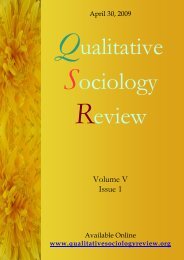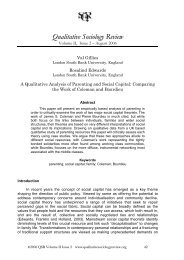volume IV is 3 - Qualitative Sociology Review
volume IV is 3 - Qualitative Sociology Review
volume IV is 3 - Qualitative Sociology Review
Create successful ePaper yourself
Turn your PDF publications into a flip-book with our unique Google optimized e-Paper software.
The problem of “representation” refers to such <strong>is</strong>sues as: reception of a given<br />
text (which <strong>is</strong> an interpretation itself) by a specific audience and the place of the<br />
author in the text in reference to “the other”. “Representation” then <strong>is</strong> usually the<br />
“presentation of oneself”, whether or not we want it to be so. It means that the<br />
presence of “the other” usually refers to the presence of the author in the text. The<br />
presented “other” <strong>is</strong> usually an alternative identity of the researcher (Denzin, Lincoln<br />
1994: 503, see also: Van Maanen 1988: 45 - 72). What <strong>is</strong> more, “the other” <strong>is</strong> not<br />
merely an exterior audience, but also the audience which <strong>is</strong> the “subject of the study”.<br />
The <strong>is</strong>sue of representation then refers to the problem of representation in the<br />
interactive dimension, with regard to broader social and structural conditioning (see:<br />
Strauss 1993: 172 – 186). The researcher (the narrator) while presenting him- or<br />
herself in a certain manner, at the same time represents a social group of academics.<br />
The intersubjective dimension of the scientific d<strong>is</strong>course <strong>is</strong> all the time present in the<br />
daily life of the field researcher (Prus 1996; Gobo 2008).<br />
The analys<strong>is</strong> of rhetorical techniques used by the author d<strong>is</strong>plays the problems<br />
of representation, which usually refers to particular literary devices (aesthetic) which<br />
are present in scientific writings, with the dominating technique of presenting “the<br />
other” known as real<strong>is</strong>tic technique (Atkinson, Hammersley 1994: 254-257 and Van<br />
Maanen 1988). It might be stated then that the presentation of “the other” <strong>is</strong><br />
impossible without representation of reality, as well as the identity of the researcher,<br />
which <strong>is</strong> closely related, at least by the mere fact of observation.<br />
When I observe my past research work, I doubt whether I really v<strong>is</strong>ited the<br />
places I describe and that I produced “real” research results (Konecki 1992a; 1992;<br />
1996). The places were culturally unfamiliar to me, and when I look back at them<br />
they seem less real from today’s perspective (should I rev<strong>is</strong>it these places?).<br />
Therefore, possibly, I wrote the methodological note to confirm my presence in these<br />
places, which serves as an observation tool, despite the fact that I stayed there as a<br />
private individual. My research reports differ in some details from what I observed in<br />
these places, a number of events and definitions did not comply with the scientific<br />
research report because some notional categories were not “saturated” enough or<br />
they occurred as idiosyncrasies and they did not fit into the theoretical framework,<br />
types (see: Glaser, Strauss 1967: 61). As a result I abandoned them. Should I have<br />
come to the conclusion that they were less real as the author’s objective research<br />
reports did not take them into consideration?<br />
As I wrote the term “author’s research reports”, I consciously used the third<br />
person singular to emphasize that ‘HE’ – the researcher – had an insight into the<br />
social reality as opposed to ‘I’, as a private individual. My observation and<br />
interpretations then, as well as producing a research report, were governed by<br />
certain conventions, exterior from my perspective. I had in my mind (often<br />
unconsciously) the prospective readers of my reports. After all, I carried the<br />
observations for somebody else, I interpreted for someone else and I wanted to write<br />
books for somebody else, despite the fact I was doing these things mainly for myself.<br />
Th<strong>is</strong> <strong>is</strong> the nature of research and scientific work. Observation as well as<br />
interpretation, analys<strong>is</strong> and description, which <strong>is</strong> indeed a representation of reality, all<br />
combine to configure one intellectual process (see: Fig. 1). The meanings and<br />
interpretations of the observed events are not establ<strong>is</strong>hed once and for all by the<br />
author, but are interwoven into a symbolic reality of a particular social context of<br />
reception of the text. From the interaction<strong>is</strong>t perspective it should be stated that the<br />
authors of field research reports write for a particular audience and apply in so doing<br />
they tend to apply certain assumptions regarding the attitudes, expectations and<br />
views of potential readers. Those readers are then the “generalized other” of the<br />
©2005-2008 <strong>Qualitative</strong> <strong>Sociology</strong> <strong>Review</strong><br />
Volume <strong>IV</strong> Issue 3 www.qualitativesociologyreview.org<br />
10


